All about lobelia
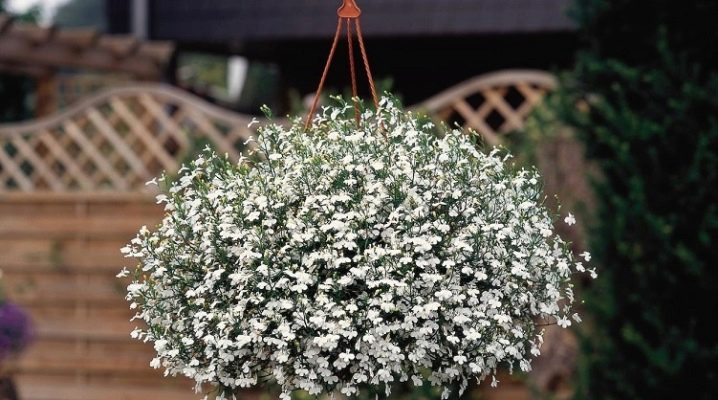
Lobelia looks equally beautiful in the garden, on the balcony or in a flowerpot. It attracts flower growers with its numerous range of shades and exuberant flowering.
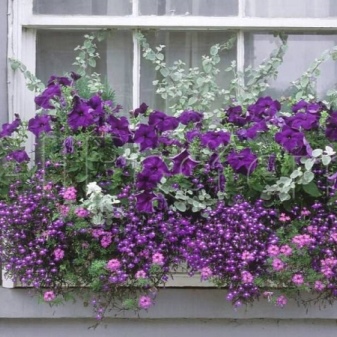
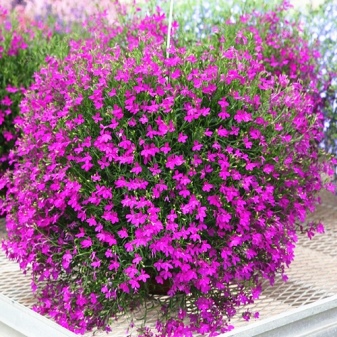
Description
Lobelia is considered to be a member of the Kolokolchikov family, although a number of scientists consider her to be a representative of the Lobelievs. The flower is found almost everywhere, but the subtropical climate is most suitable for it. Today, there are about 300 species of this plant, some are used for the manufacture of medicines. Only about 20 species are cultivated at home.
Shoots are thin, rather branched, can be both erect and hanging. It has lobelia and creeping varieties that cover the soil beautifully. Ampel forms reach a height of 10-20 cm, and straight stems grow up to 50 cm. Leaf plates are located on the shoot along the entire length in a regular order and have a lanceolate shape. The entire leaf is deep green and covered with short silvery hairs, the stems have the same coverage.
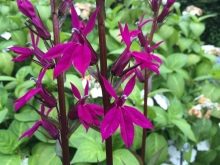
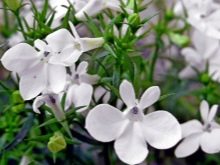
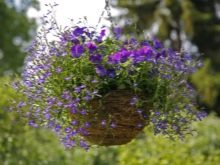
The main feature of lobelia is its numerous flowers. They open in the axils of the apical shoots in the summer on short peduncles. The flowers are small, two-lipped, with slightly smaller upper petals. In their middle are low stamens with anthers. The color of the petals is very diverse, it can be either one-color or with a prominent eye. With its abundant flowering and pleasant aroma, the plant attracts various insects, which pollinate it.
After pollination, in place of the buds, small two-chambered capsules with seeds are formed. They are very small, dark brown. Suitability for germination of seeds is long, up to three years.
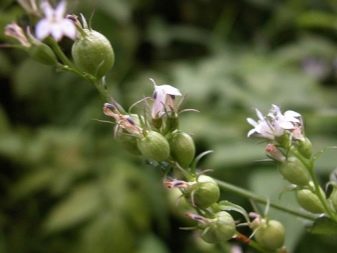
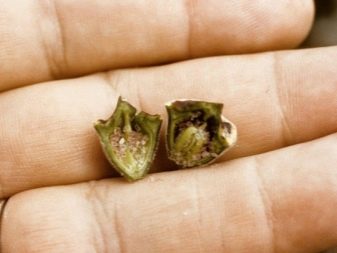
Popular varieties
Lobelia amazes with an extraordinary number of species and varieties, among which there are both annuals and those that can grow for several years.
Erinus is one of the most famous and widespread species. The plant belongs to perennials, forms compact rounded bushes with abundant greenish foliage. The leaf plates are medium-sized, elongated, with jagged edges. Blooms in June and pumps flowering in late autumn. The buds have a variety of colors depending on the variety.

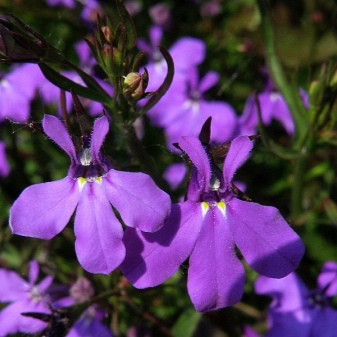
Lobelia erinus is divided into five groups, depending on the shape of the bush:
- Pendula - ampelous varieties with hanging elongated shoots reaching 35 cm;
- Erecta - erect stems form a small columnar bush 20-25 cm high;
- Compacta - squat shrubs with numerical leaf blades;
- Diffusa - miniature bushes with long branchy shoots and tiny flowers;
- Pumila - dwarf varieties, reaching no more than 12 cm.
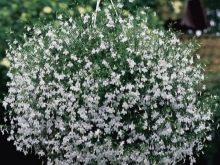
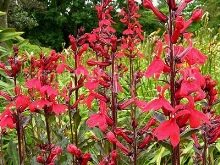
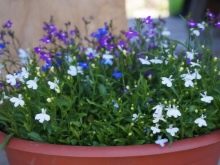
Bush-shaped varieties include:
- "Crystal Palace" - a lush plant with small purple flowers;
- "Emperor William" or "Emperor Willie" - belongs to mini varieties, reaching only 10 cm, has blue flowers;
- Mrs Clebran - a well-branched bush, has bright purple petals and a snow-white center;
- Cambridge Blue - undersized shrub with lush stems and small flowers of light purple color with a blue tint;
- "White Palace" - a small bush blooming with delicate snow-white buds;
- "Kaiser Wilhelm" - a squat plant blooming in a blue tone;
- "Schneeball" - has small white flowers and rather branched shoots;
- "String of pearls" - a small bush with flowers of different colors;
- "Rosamund" - a variety that does not have a special height with raspberry buds;
- Blauer Edelstein - has flowers of a cornflower-blue tone, the bush itself is compact in size.
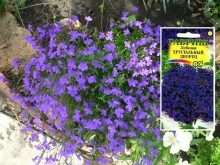


Ampel varieties include:
- "Sapphire" - with sprawling long shoots and blue flowers with a white center;
- "White Lady" - possesses tiny snow-white flowers, the bush is branched and rather dense;
- "Blue Fountain" - the falling shoots are covered with blue inflorescences with a snow-white center;
- "Red cascade" - elongated shoots, with abundant lilac-pink flowers;
- "Regatta Rose" - possesses pinkish-crimson buds with a white spot, stems are long, flexible;
- "Cascade Mix" - this is a mixture of ampelous varieties with long stems, flowers have different colors: white, pink, blue, lilac;
- "Marquis" - with beautifully cascading shoots and red buds.
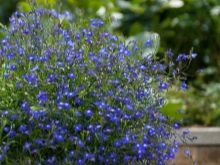
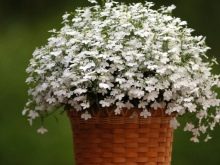
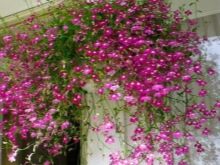
The purple or cardinal lobelia belongs to the frost-hardy species. Erect shoots form rather tall bushes, can reach a meter in height. Flowers are small, scarlet in color, formed on spike-shaped peduncles. This variety needs frequent, abundant watering, and feels great in lowland and swampy places. This species is often used as an aquarium plant.
The plant, planted on the banks of the pond, grows very quickly and enters even in shallow water. Bushes growing near reservoirs are more splendid. The most famous variety is Ruby Slippers, with delicate pink-crimson flowers.
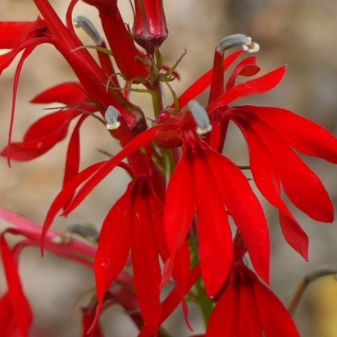
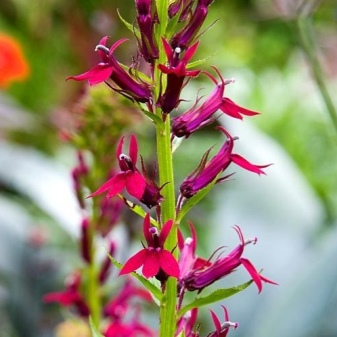
Shiny or fiery is a perennial plant, but it needs to be very well covered for the winter. It blooms with red buds, the color of the leaf plates depends on the varietal characteristics and can vary from light green to reddish. The height of the bush varies from 70 cm to 1.5 m.The most impressive varieties are "Queen Victoria" with red flowers and purple leaf plates, and "Russian princess" - a large bush with reddish-crimson flowers, shaded by leaf plates of a bronze-purple tone.
Blue lobelia also belongs to perennials. Blue or purple flowers form elongated spikelet-shaped inflorescences. The bush itself is straight, not branched. The species is not very popular, but as a result of crossing with purple and shiny lobelia, the eminent variety "Compliment" was bred.
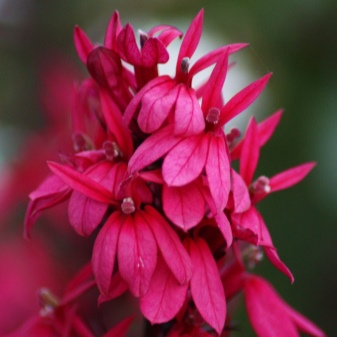
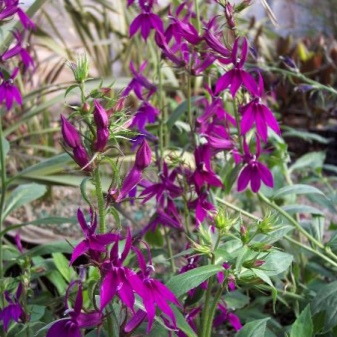
Lobelia Dortmann is a very rare plant listed in the Red Book. In its natural environment, it grows in coastal areas of water bodies and shallow waters. It blooms with blue or white bells.
Beautiful lobelia is distinguished by its large bush with large flowers of bright red, crimson or lilac color. Shoots are strong, elongated, with large leaf blades. The plant is frost-resistant, in mild climates it can hibernate without shelter, in other regions it requires shelter for the winter. The most famous of the varieties "Compliment Deep Red" with velvety flowers of a rich red hue, which are effectively set off by the green tone of the leaves and shoots.
Also known "Fan Scarlett" - a small bush with bright red inflorescences.
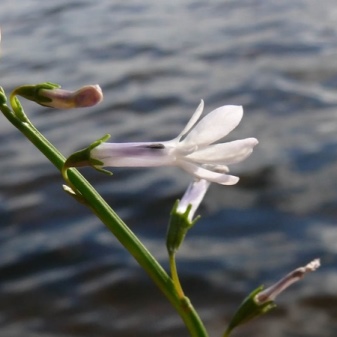
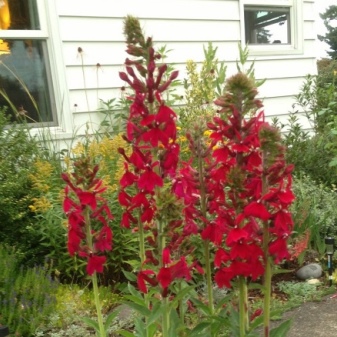
The sessile variety has blue or light purple flowers that form an apical raceme. It belongs to winter-hardy crops, but needs shelter in cold winters.
Lobelia Gherardi is a fairly voluminous shrub with frost resistance. The flowers are colored blue or purple, forming long spikelet-shaped inflorescences. Of the varieties, the most common is "Vedrariensis".
Strong lobelia is similar to Erinus, but the shoots are rougher and the leaves are large. The shape of the bush is columnar or branched. Inflorescences can be blue and purple, with a white spot in the middle.
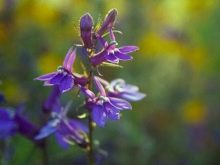

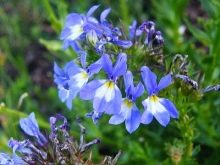
The thinnest one answers its name, the shoots are thin, graceful, with large beautiful flowers of lilac or pink color. Bushes are compact, neat in shape. The most common variety is Blue wings, with elongated stems and bright blue inflorescences.
Lobelia Richard - climbing variety, has elongated harsh shoots... Can be planted as a ground cover crop or in hanging pots. The buds are blue, white or lavender.
White - a small spherical bush with numerous snow-white flowers that form in the axils of the leaf plates.
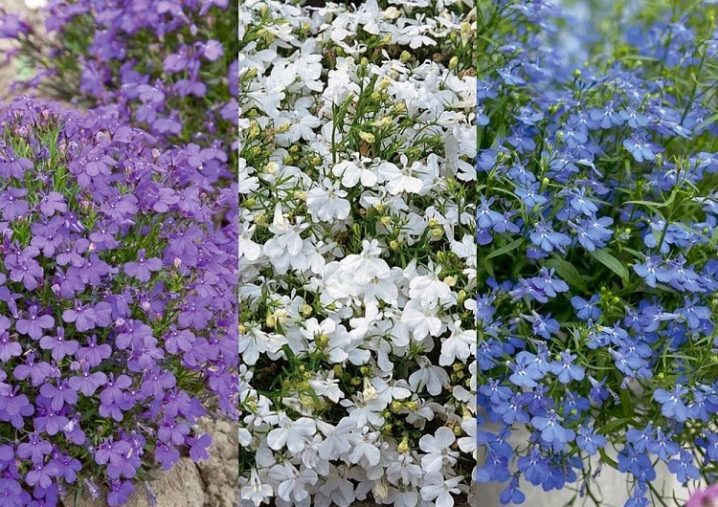
Planting and care at home
In addition to open ground, lobelia grows remarkably in flowerpots, hanging pots and a variety of vessels. Ampel varieties are suitable for pots. The soil for the plant should be fairly loose, light and well moisturized. Suitable soil is neutral or slightly acidic; peat, sand and humus are taken as components. Some growers recommend adding hydrogel and delayed fertilizers to the substrate.
Thanks to such measures, you can not use daily watering and frequent feeding. To retain moisture longer, the soil is also supplemented with moss. For planting, use mature and slightly grown seedlings. A drainage ball is laid out on the bottom of the pot, then a little earth and the sprouts are neatly placed, sprinkled with the remaining substrate.
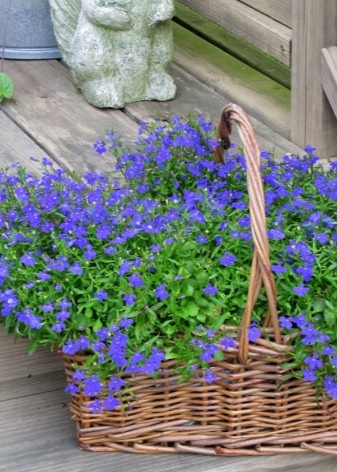

The soil is moistened, and the container is placed in a lighted place.
You can immediately plant seeds in pots without using the seedling method. To do this, in April, seed material is planted in hanging baskets, then, lightly sprinkled with earth, sprayed with water, covered with foil and placed in a well-lit, warm place. We must not forget to water and ventilate the greenhouse. When sprouts appear, the shelter is removed, and when warm weather sets in, the pots can be taken out into the air. It is necessary to plant several sprouts in one container, you can experiment with different colors of flowers, so the bush looks much more spectacular.
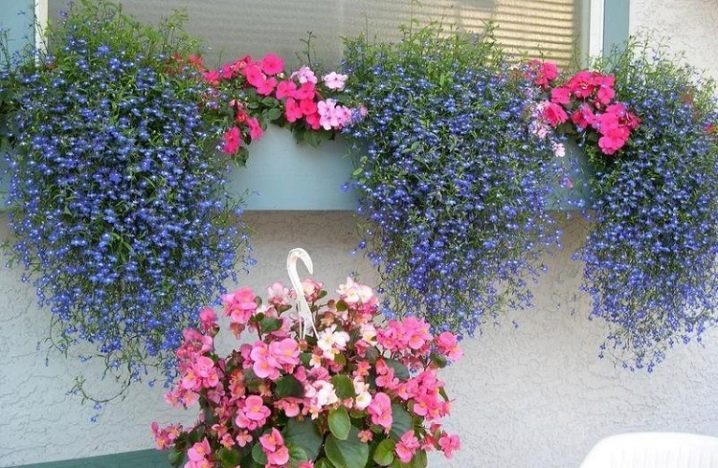
Lobelia loves warm air, feels great in well-lit places and partial shade. Watering is necessary moderate and frequent; in the heat, the plant needs to be moistened in the morning and evening. There are varieties that love abundant hydration. Poorly tolerates drought and may stop blooming. If containers with lobelia are in the yard, during the rain it is necessary to prevent excessive flooding of the flower.
Bushes are fed every two months for more abundant flowering. Sodium sulfate is used for the first time, then complex feeding. Irrigation of leaf plates with complex fertilizers and microelements diluted in water will be useful. Dried and withered parts of lobelia should be periodically removed, and too elongated shoots should be pinched. A plant in hanging pots looks beautiful if it is given a spherical shape.
The formation of the bush gives the lobelia a more flavorful and beautiful appearance, and also stimulates better flowering. Growing a lobelia as a houseplant is not a particularly laborious process, and even a beginner in floriculture can handle it.
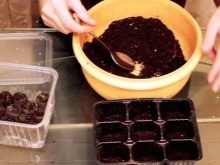
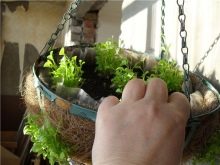

How to grow outdoors?
Before planting in the garden, the seedlings must be properly hardened. To do this, the seedlings are placed in the shade in the open air during the day, the weather should be warm and calm. The next day it is taken out in partial shade, and only then can it be put in the sun for an hour. Planting depends on what kind of plant you want to end up with. To form scattered bushes, seedlings are planted in small holes every 25 cm, and if they want to get a continuous cover - after 10-15 cm.

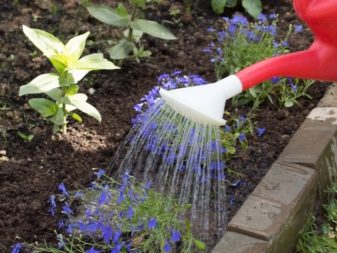
Lobelia is unpretentious in care and does not require much attention. The soil is loose, with good water permeability. It is better not to plant on fertile soil, since the greenery of the plant will grow well there, but flowers may not appear.For an abundance of flowering, they are fed with sodium sulfate, and they provide moderate moisture. Lobelia grows remarkably well in well-lit areas, but thrives just as well in places where bright light lasts only 2-3 hours.
Flowering times are different for all species, but most bloom before frost. Perennial species for the winter are well wrapped up and left on the site. Or you can dig up the plant, keep it indoors and plant it in the garden next spring.
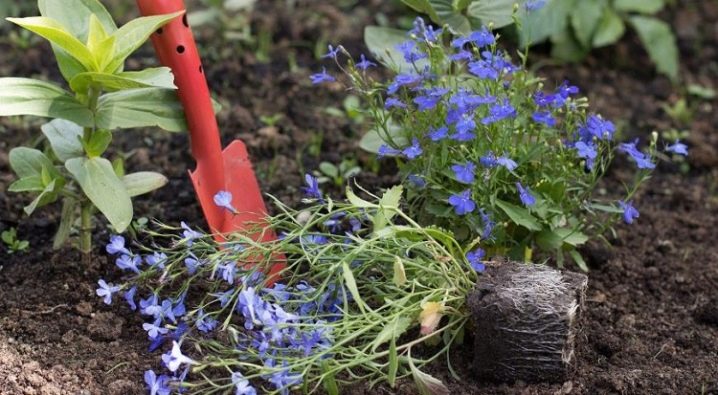
Reproduction
There are several ways to dilute lobelia:
- seeds;
- cuttings;
- dividing the roots.
Cultivation of lobelia primarily begins with sowing seeds, since this is the main method for planting a plant. Seed material is planted in February-March using a seedling cassette, peat tablets or plastic containers. You can take the land purchased for seedlings of flowers, or you can cook it yourself. To do this, mix the forest in equal proportions earth, peat and sand, add a little humus.
Drainage is laid out in the cassettes at the bottom, it can be expanded clay or crushed bark, then a little well-loosened earth.
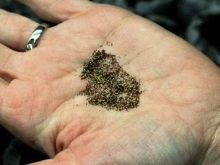
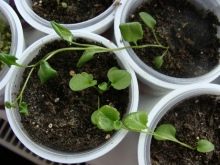
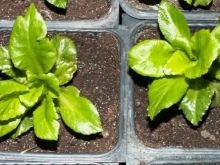
Moisturize abundantly and wait for it to sag slightly. After that, seeds mixed with sand are spread on it and sprinkled with a thin layer of the same sand, they are not buried in the soil, so the seedlings may not grow. The cassette is covered with film and placed in a place with bright diffused light. The same conditions are created for seeds in peat tablets, but watering is best done through the pallet. It is not necessary to plant the sprouts, they can be planted directly in the open ground.
To grow in a container, you first need to make drainage holes in it and fill it with a substrate, moisten well. Seeds are laid out on the soil together in several pieces and lightly pressed, they do not sprinkle with earth. Moistened with a spray bottle and covered with polyethylene or glass, left in a warm, bright place. The temperature for seed germination ranges from + 20-22 degrees, and after the sprouts appear, it must be reduced to +15 degrees.
The soil should be moist all the time, and the seedlings should also be ventilated.

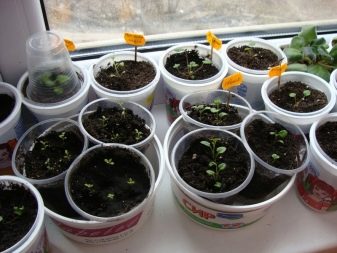
The film must be removed gradually, and when the sprouts reach 1 cm, it can be removed... If seeds are sown in February, they need to create additional lighting, March seedlings can do without it. To prevent small sprouts from leaning to the ground during watering, they need to be moistened at the base of the stem, for this you can use a regular syringe. This method of watering will protect the seedlings from the black leg disease, which appears from the ingress of water on the plant. So watered until the sprouts get stronger.
You can dive monthly seedlings, they are seated in several pieces in a glass, watered, and kept in a shaded place for a couple of days, then put back into the light. After the sprouts grow up to 3-4 cm, they need to be pinched, this contributes to greater branching of the shoots and the formation of roots. If pinching is applied several times, a rather lush bush forms in the future. This can be done with ordinary scissors, simply cutting off the tops of the seedlings.
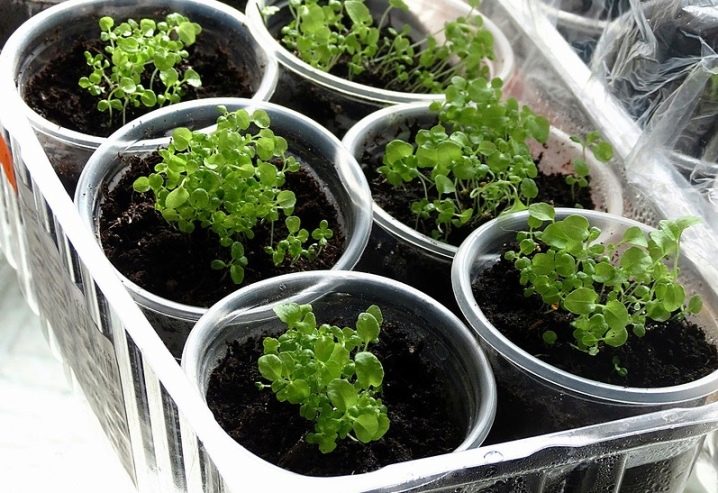
A method of sowing lobelia seeds on snow is also used. To do this, in the selected area, seeds mixed with sand are spread on a layer of snow. After the thaw, the seedlings will have enough moisture and begin to grow in 10-12 days. When 3-4 leaves are formed, the seedlings dive, planting 4-5 pieces.
Cuttings are used mainly for highly decorative terry varieties. They are cut into 8-10 cm pieces and left to root in water or a container with damp earth. When roots appear, the plants are planted in well-loosened soil and moderately moistened, avoiding stagnation of water, and making sure that the soil does not dry out completely. Reproduction by dividing the rhizomes is carried out in the spring, since then shoots are formed on the lobelia.The plant is dug up and divided into several parts, each bush is planted in separate, prepared pits.
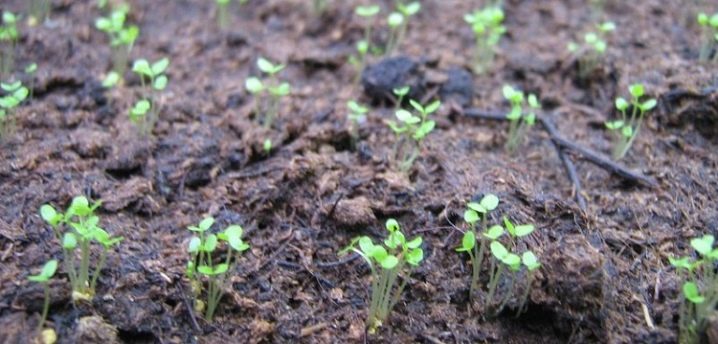
Application in landscape design
Due to the varied range of colors, lobelia is widely used in decorating gardens and backyard areas. The plant is perfect for decorating flower beds, alpine slides, a variety of borders. It looks just as impressive in various compositions in flower beds. Artificial reservoirs decorated with lobelia bushes look much more spectacular. Landscape designers prefer blue, purple or lobelia Gherardi varieties for this decor.
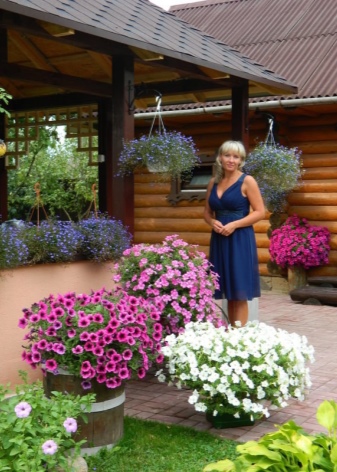
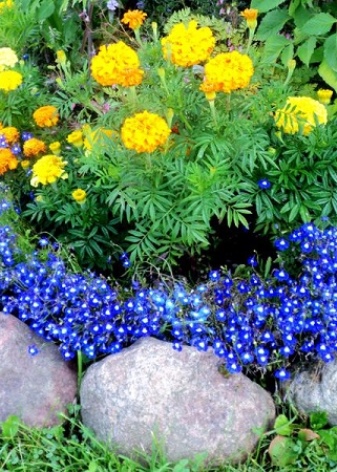
Voluminous, but squat bushes of bright colors look great on alpine slides or in rockeries. Lobelia bushes are often planted along paths or on the first line of mixborders, as well as in graceful ridges. Delicate spherical bushes stand out against the background of lawns or other deciduous plants. The plant planted in clumps on the lawn looks impressive. Due to its many shades of flowers, lobelia is ideal for this decor.

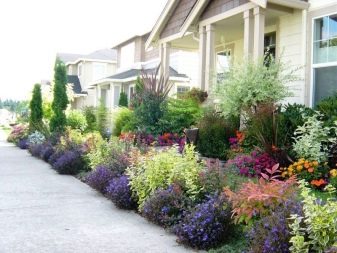
Blue-flowered varieties are used to mimic a spring, or you can create a beautiful "flowing" trickle from an inverted large vessel. The multi-colored buds of the plant allow imagination to roam with might and main.
Ampel varieties hang gorgeous from large floor pots or hanging planters that can be used to decorate balconies and terraces.
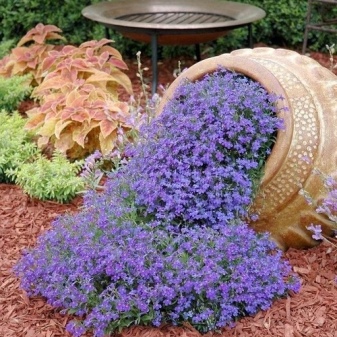
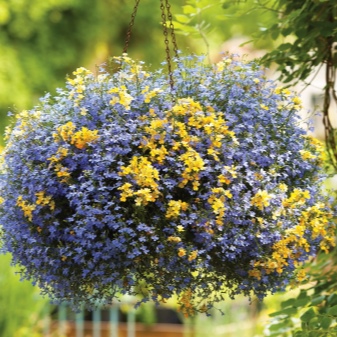
In the next video, you are waiting for the cultivation of lobelia from sowing to flowering.
































































































The comment was sent successfully.